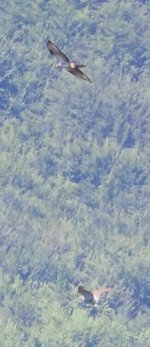Biancone
to err is human
I've got a bit of a puzzle. A couple of days ago (17 July 2018) I was overlooking a wooded valley in the northern Apennines looking primarily for Honey-buzzards in flight. Just after noon I spotted a raptor as it rose above the skyline, then a second below it. The first was certainly a Honey-buzzard, a pale bird circling quite briskly. My impression of the second was of another large raptor, medium dark above, perhaps brownish, but showing a large white area around the tail base which immediately suggested the undertail coverts of a possible Goshawk, always so eye-catching when flared. The distance, estimated between 1 and 1.5 km, did not allow me to see much significant detail (I don't use a scope) but the second bird was not moving as might be expected for a Goshawk and I realised it was carrying some substantial prey item. It soon moved back below the skyline and flew fast but with laboured wingbeats as it descended out of sight into the head of one of the smaller side valleys. The Honey-buzzard followed the same general course, keeping 50-100 metres above the second bird.
The narrative I immediately concocted in my head was that the second bird was a Goshawk that had snatched a recently hatched Honey-buzzard chick from the nest and was carrying it back to its own young (Goshawks breed relatively late here, with young flying in the second half of July), and the first bird was one of the deprived parents.
My little story is entirely plausible, but could be entirely wrong. Perhaps the proximity of first and second birds was just chance. Perhaps the second was not a Goshawk. Perhaps what I first thought were flared undertail coverts was the mainly white prey bird. Perhaps the prey was someone's white chicken.
But, disregarding my narrative, what about my hawk identification? Is there enough evidence in the images alone to confirm my first impression that it was a Northern Goshawk? Additional opinions welcome, including dissenting ones, with reasons why!
The first image below shows the general spatial relationship of both birds. The second is a composite strip of successive images of the second bird with prey, all frustratingly fuzzy. The dangling legs I'm sure belong to the prey. The horizontal orange line added to some images indicates the axis of the hawk's tail.
Brian
The narrative I immediately concocted in my head was that the second bird was a Goshawk that had snatched a recently hatched Honey-buzzard chick from the nest and was carrying it back to its own young (Goshawks breed relatively late here, with young flying in the second half of July), and the first bird was one of the deprived parents.
My little story is entirely plausible, but could be entirely wrong. Perhaps the proximity of first and second birds was just chance. Perhaps the second was not a Goshawk. Perhaps what I first thought were flared undertail coverts was the mainly white prey bird. Perhaps the prey was someone's white chicken.
But, disregarding my narrative, what about my hawk identification? Is there enough evidence in the images alone to confirm my first impression that it was a Northern Goshawk? Additional opinions welcome, including dissenting ones, with reasons why!
The first image below shows the general spatial relationship of both birds. The second is a composite strip of successive images of the second bird with prey, all frustratingly fuzzy. The dangling legs I'm sure belong to the prey. The horizontal orange line added to some images indicates the axis of the hawk's tail.
Brian







